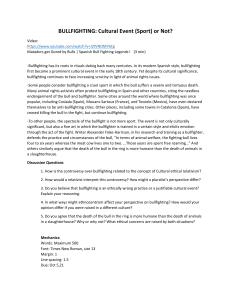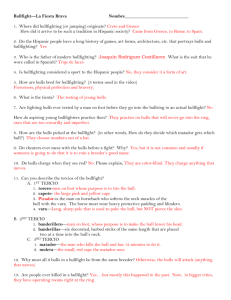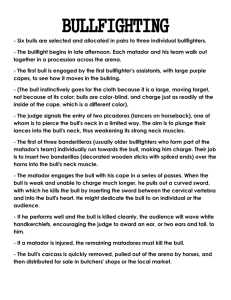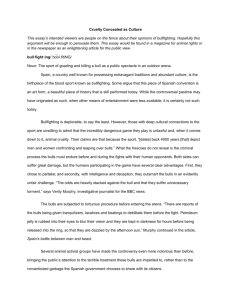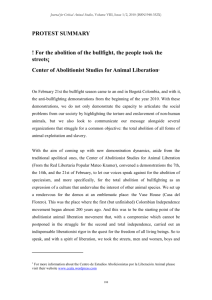the bullfight is not a sport - Alliance Gertz
advertisement
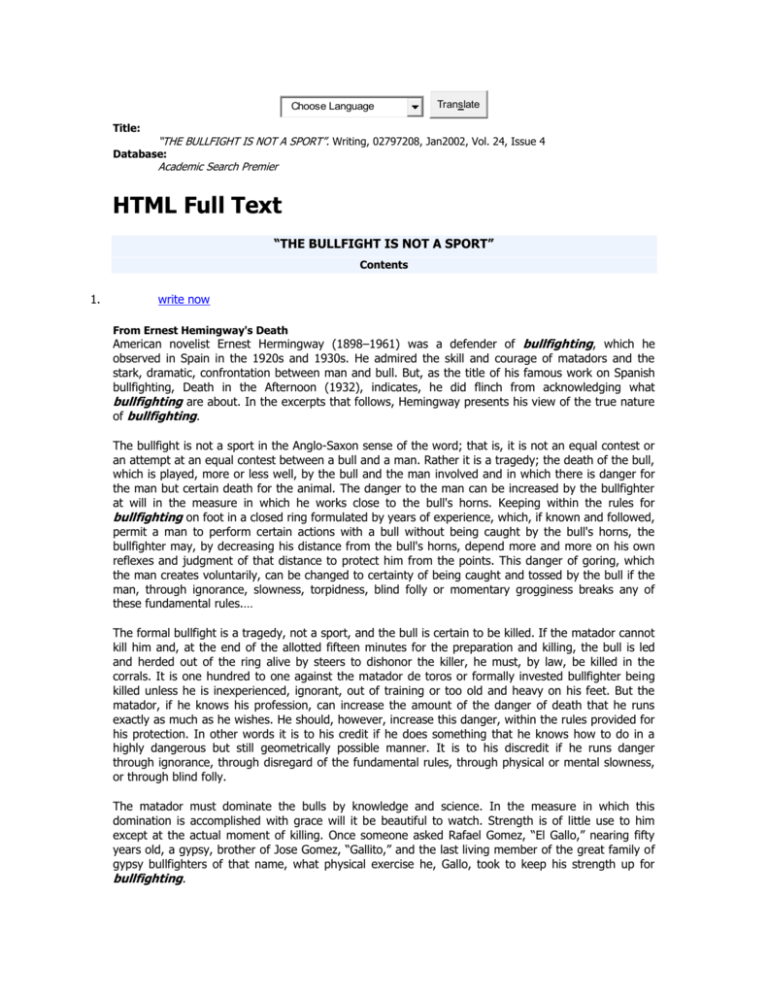
Choose Language Title: Translate “THE BULLFIGHT IS NOT A SPORT”. Writing, 02797208, Jan2002, Vol. 24, Issue 4 Database: Academic Search Premier HTML Full Text “THE BULLFIGHT IS NOT A SPORT” Contents 1. write now From Ernest Hemingway's Death American novelist Ernest Hermingway (1898–1961) was a defender of bullfighting, which he observed in Spain in the 1920s and 1930s. He admired the skill and courage of matadors and the stark, dramatic, confrontation between man and bull. But, as the title of his famous work on Spanish bullfighting, Death in the Afternoon (1932), indicates, he did flinch from acknowledging what bullfighting are about. In the excerpts that follows, Hemingway presents his view of the true nature of bullfighting. The bullfight is not a sport in the Anglo-Saxon sense of the word; that is, it is not an equal contest or an attempt at an equal contest between a bull and a man. Rather it is a tragedy; the death of the bull, which is played, more or less well, by the bull and the man involved and in which there is danger for the man but certain death for the animal. The danger to the man can be increased by the bullfighter at will in the measure in which he works close to the bull's horns. Keeping within the rules for bullfighting on foot in a closed ring formulated by years of experience, which, if known and followed, permit a man to perform certain actions with a bull without being caught by the bull's horns, the bullfighter may, by decreasing his distance from the bull's horns, depend more and more on his own reflexes and judgment of that distance to protect him from the points. This danger of goring, which the man creates voluntarily, can be changed to certainty of being caught and tossed by the bull if the man, through ignorance, slowness, torpidness, blind folly or momentary grogginess breaks any of these fundamental rules.… The formal bullfight is a tragedy, not a sport, and the bull is certain to be killed. If the matador cannot kill him and, at the end of the allotted fifteen minutes for the preparation and killing, the bull is led and herded out of the ring alive by steers to dishonor the killer, he must, by law, be killed in the corrals. It is one hundred to one against the matador de toros or formally invested bullfighter being killed unless he is inexperienced, ignorant, out of training or too old and heavy on his feet. But the matador, if he knows his profession, can increase the amount of the danger of death that he runs exactly as much as he wishes. He should, however, increase this danger, within the rules provided for his protection. In other words it is to his credit if he does something that he knows how to do in a highly dangerous but still geometrically possible manner. It is to his discredit if he runs danger through ignorance, through disregard of the fundamental rules, through physical or mental slowness, or through blind folly. The matador must dominate the bulls by knowledge and science. In the measure in which this domination is accomplished with grace will it be beautiful to watch. Strength is of little use to him except at the actual moment of killing. Once someone asked Rafael Gomez, “El Gallo,” nearing fifty years old, a gypsy, brother of Jose Gomez, “Gallito,” and the last living member of the great family of gypsy bullfighters of that name, what physical exercise he, Gallo, took to keep his strength up for bullfighting. “Strength,” Gallo said. “What do I want with strength, man? The bull weighs half a ton. Should I take exercises for strength to match him? Let the bull have the strength.” If the bulls were allowed to increase their knowledge as the bullfighter does and if those bulls which are not killed in the allotted fifteen minutes in the ring were not afterwards killed in the corrals but were allowed to be fought again they would kill all the bullfighters, if the bullfighters fought them according to the rules. Bullfighting is based on the fact that it is the first meeting between the wild animal and a dismounted man. This is the fundamental premise of modern bullfighting: that the bull has never been in the ring before.… You would think…that it would make of bullfighting a true sport, rather than merely a tragic spectacle, if bulls that had been in the ring were allowed to reappear. I have seen such bulls fought, in violation of the law, in provincial towns in improvised arenas made by blocking the entrances to the public square with piled-up carts in the illegal capeas, or town-square bullfights with used bulls. The aspirant bullfighters, who have no financial backing, get their first experience in capeas. It is a sport, a very savage and primitive sport, and for the most part a truly amateur one. I am afraid however due to the danger of death it involves it would never have much success among the amateur sportsmen of America or England who play games. We, in games, are not fascinated by death, its nearness and its avoidance. We are fascinated by victory and we replace the avoidance of death by the avoidance of defeat. It is a very nice symbolism but it takes more [courage] to be a sportsman when death is a closer party to the game.

